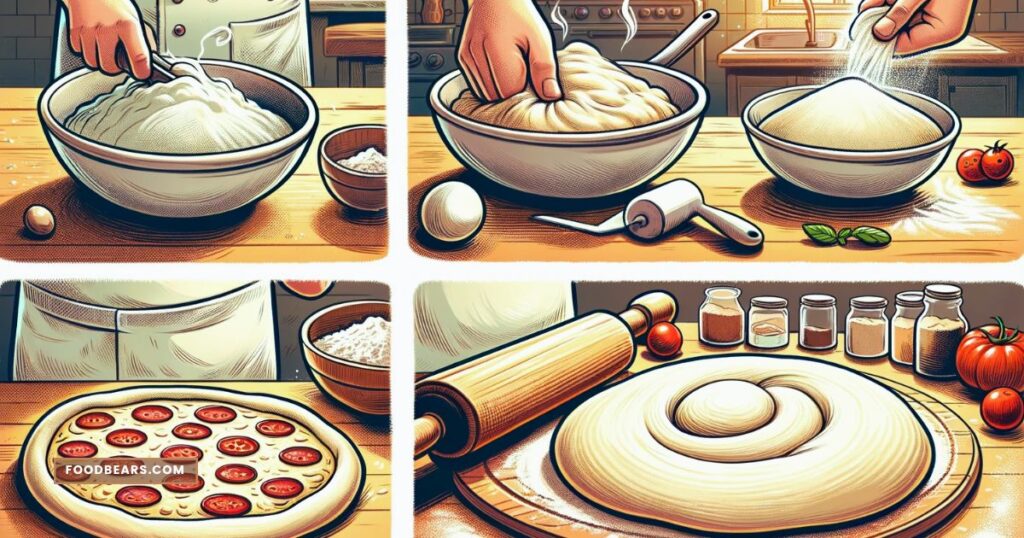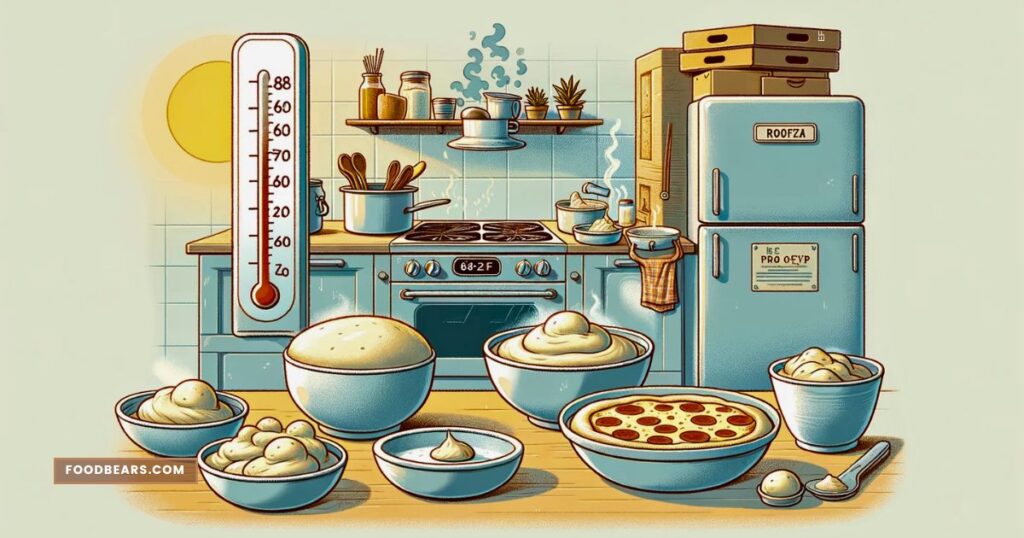The answer is yes and no. Pizza dough consists of flour, yeast, water, salt, and sometimes sugar and oil.
Pizza is one of the beloved dishes around the world, with many different variations and flavors. One of the essential elements of any pizza is the dough.
The dough gives the pizza its structure, texture, and flavor. Almost every pizza recipe outlines the importance of allowing the dough to rise. But does pizza dough need to rise?
However, some pizza recipes utilize other rising methods, such as baking powder or omitting the rising process altogether.
In this article, we’ll explore the reasons behind the traditional rise of pizza dough, alternative methods, and what differences they will make in the final result.
The Science Behind Pizza Dough Rising

When you make your pizza dough, the rising is a crucial step. But what happens at this stage? The science behind dough rising is fascinating and varies among dough recipes.
Yeast Fermentation
The magic behind dough rising lies in yeast fermentation. In this process, yeast consumes sugars, producing carbon dioxide and alcohol. This reaction causes the dough to rise, creating that airy texture we all adore. But that’s not all – fermentation also imparts a distinct flavor to the dough.
Temperature
Temperature also plays a vital role in dough rising. Yeast is most efficient at around 37°C, but higher temperatures can cause the dough to rise too quickly, resulting in a less desirable texture.
On the other hand, cooler temperatures can slow down or even halt the rising process. Bakers often use warm water to optimize the conditions for dough rising and place the dough in a warm environment, such as a proofing box or a warm oven.
Getting the timing and temperature right is vital to achieving the perfect rise and making delicious, fluffy bread.
Gluten Development
Gluten, a protein found in wheat flour, is the unsung hero of pizza dough. It affects the dough’s elasticity and structure, striking that perfect balance between chewiness and crispiness. If you’ve ever kneaded dough, you’ve witnessed gluten working its magic.
To Rise or Not to Rise: Comparing Pizza Dough Types

As you may know, countless pizza styles exist worldwide, and not all doughs are created equal. Explore a few types and see how rising times influence their characteristics.
| Pizza Dough Type | Rising Time | Texture | Flavor |
|---|---|---|---|
| Neapolitan | 6-24 hours | Light, airy | Rich |
| New York-Style | 1-2 hours, or 24 hours in the fridge | Thin, foldable | Enhanced when refrigerated |
| No-Rise | None | Denser | Simpler |
| Sourdough | 8-48 hours | Chewy | Tangy |
Neapolitan Pizza Dough
Originating from Naples, Italy, Neapolitan pizza dough epitomizes traditional pizza. This dough requires time to rise, with a minimum of 6 hours at room temperature.
However, if you’re after an exceptional flavor and texture, letting it rise for up to 24 hours is the way to go. Trust me – it’s worth the wait!
New York-Style Pizza Dough
New York-style pizza is renowned for its thin, foldable crust. This dough benefits from a rising time of 1 to 2 hours at room temperature.
You can also let it rise for 24 hours in the fridge for a more complex flavor. The choice is yours!
No-Rise Pizza Dough
We’ve all had those days when time is scarce, and pizza cravings strike. Enter no-rise pizza dough, the quick and easy solution for busy schedules.
While this dough lacks some flavor complexity and elasticity, it’s a convenient alternative when time is of the essence.
Sourdough Pizza Dough
Sourdough pizza dough uses a starter of naturally occurring wild yeast and lactic acid bacteria. This unique combination results in a tangy taste and a chewier crust.
Remember that sourdough pizza dough demands a longer fermentation time for optimal results – a minimum of 8 hours at room temperature or up to 48 hours in the fridge for maximum flavor development.
Tips for Rising Pizza Dough

Now that we’ve examined different dough types, let’s discuss how to create the perfect environment for your dough to rise.
Optimal Rising Conditions
The ideal temperature for dough rising is between 75°F and 85°F, with a humidity level of 60% to 70%.
To replicate this environment at home, try using an oven with the light on or placing the dough in a covered bowl with a damp cloth. Your dough will thank you!
Knowing When the Dough Has Risen Enough
So, how can you tell if your dough is ready? Look for it to double in size and try the finger dent test: gently press a finger into the dough, and if the indent remains, it’s good to go.
How To Make the Best Basic Pizza Dough?

You can experiment with different flour types, rising times, and baking methods to achieve your ideal pizza crust texture and flavor. To make the best basic pizza dough, follow these steps:
- Gather ingredients: Typically, you’ll need flour (all-purpose or bread flour), water, yeast (instant or active dry), salt, sugar, and olive oil.
- Activate yeast: If you use active dry yeast, dissolve it in warm water (around 110°F or 43°C) with sugar, and let it sit for 5-10 minutes until foamy. You can add instant yeast directly to the dry ingredients.
- Mix and knead: Combine all ingredients in a mixing bowl. Then, knead the dough by hand or using a bowl of a stand mixer with a dough hook attachment for 8-10 minutes. Knead and stretch the dough until it is smooth and elastic.
- First rise: Form the dough into a ball, place it in a greased bowl, and cover it with plastic wrap or a damp cloth. Let it rise at room temperature until it doubles in size, approximately 1-2 hours.
- Shape it: Once the dough has risen, divide it into portions (if needed), and shape each into a smooth ball. Cover and let the dough balls rest for 20-30 minutes before stretching them into pizza crusts.
- Preheat oven: Preheat your oven to its highest temperature with a pizza stone or baking steel inside.
- Add toppings: Stretch the dough into your desired shape. Add sauce, cheese, and other toppings, then transfer to the preheated pizza stone or baking steel.
- Bake: Now it is ready to bake. Place it in the oven and bake for 8-12 minutes until the crust is golden and the cheese is bubbly and slightly browned.
How Long Should Pizza Dough Be Proof at Room Temperature?

You must monitor the dough closely to achieve the best results, as the room temperature can vary. Proofing pizza dough at room temperature involves the following considerations:
- Ideal time: Typically, proofing takes 1-2 hours at room temperature (around 68-72°F or 20-22°C).
- Dough size: Smaller dough portions may prove faster, while more significant portions may require additional time.
- Yeast activity: The rate of yeast fermentation affects proofing time; fresh and active yeast may work more quickly.
- Desired results: For a light, airy crust, ensure the dough roughly doubles in size during proofing.
What Happens If I Don’t Let My Pizza Dough Rise?
If you don’t let your pizza dough rise, it will lack the necessary fermentation time, resulting in a dense, less flavorful crust. The yeast in the dough needs time to consume sugars and produce carbon dioxide, which gives the dough its airy texture.
If you skip this step, the dough becomes difficult to stretch and shape, as it lacks the elasticity provided by gluten development.
The Maillard reaction relies on the byproducts of fermentation for its desirable color and taste. So, you will not get the same golden-brown appearance in the crust. To achieve a delicious, airy pizza crust, allow the dough to rise according to recipe instructions.
How to Enhance Dough Flavor and Texture
If you want a flavorful pizza, here are some tips for enhancing your dough’s flavor and texture:
- Cold fermentation: Let your dough rise slowly in the refrigerator overnight or for 24 to 72 hours. This extended fermentation period allows for more complex flavors to develop.
- Pre-ferments: Use a pre-ferment, like a poolish or a biga, to add flavor and improve the dough’s texture.
- Autolyse: Rest your dough for 20-30 minutes after mixing the flour and water before adding the yeast and salt. This process allows the flour to hydrate and enzymes to break down the starches and proteins. It will improve the dough’s extensibility and overall structure.
How Long Should I Let My Pizza Dough Rise?
The rising time for pizza dough depends on the type of dough and your desired results.
Neapolitan dough typically requires 6-24 hours, New York-style dough needs 1-2 hours or 24 hours in the fridge, and sourdough pizza dough demands 8-48 hours.
No-rise pizza dough does not require rising time but may compromise flavor and texture.
The ideal rising time for pizza dough varies depending on these factors:
- Recipe: Some recipes may call for different rising times. So, follow the specific instructions.
- Temperature: Pizza dough requires 1-2 hours for the first rise. A warmer environment (around 75-80°F or 24-27°C) typically speeds up fermentation, and Cooler temperatures may necessitate longer rising times.
- Yeast type: Instant yeast generally hastens the process, while active dry yeast might take longer.
- Desired flavor and texture: A longer rise (e.g., in the refrigerator for 24-72 hours) can generate a more complex flavor and improved texture.
Closely monitor the dough during the rising process. The yeast has sufficiently fermented the dough if it gets roughly double in size. Balance these factors to achieve the perfect rise for a delicious, airy pizza crust.
How to Solve Some Common Dough Problems
Sometimes things don’t go as planned, and our dough doesn’t turn out how we want. Fear not – I’ve covered you with some common dough problem troubleshooting tips.
Over-proofed Dough
If your dough collapses when you handle it and has an excessively yeasty flavor, it’s likely over-proofed. To save it, gently deflate the dough and reshape it, then let it rise for a shorter period.
Under-proofed Dough
On the other hand, under-proofed dough results in a dense and chewy crust that doesn’t rise enough during baking. To fix this, allow the dough more time to rise and ensure you provide the optimal rising conditions we discussed earlier.
Sticky Dough
Sometimes, the dough can become sticky and difficult to handle. This issue often stems from high humidity or too much liquid in the dough. Gradually add more flour while kneading until the dough reaches the desired consistency this.
Dry Dough
A dry and crumbly dough can be frustrating to work with. This issue might arise due to insufficient hydration or over-kneading. To remedy this, try incorporating small amounts of water into the dough until it becomes more pliable.
FAQ
Do I need to let my pizza dough rise?
Allowing your pizza dough to rise improves its flavor, texture, and overall quality. Rising times vary depending on the type of dough you’re making, but most doughs benefit from a rising period to allow the yeast to ferment and create a light, airy crust.
How do I know when my pizza dough has risen enough?
To determine if your pizza dough has risen enough, look for it to double in size. You can also perform the finger dent test: gently press a finger into the dough, and if the indent remains, it’s ready to be shaped and baked.
Can I over-proof my pizza dough?
Yes, over-proofing can happen if pizza dough rises too long, resulting in a dough that collapses when handled and has an excessively yeasty flavor. To rescue over-proofed dough, gently deflate, reshape, and let it rise for a shorter period.
What are the optimal conditions for pizza dough to rise?
The ideal conditions for pizza dough rising are temperatures between 75°F and 85°F, with a humidity level of 60% to 70%. To achieve this environment at home, use an oven with the light on or place the dough in a covered bowl with a damp cloth.
Conclusion
So, does pizza dough need to rise? The answer depends on the type of pizza you’re making and the flavor and texture you desire.
While some doughs, like Neapolitan and New York-style, benefit from rising times, no-rise pizza dough offers a convenient alternative when time is of the essence.
And if you’re craving a tangy, chewy crust, sourdough pizza dough is worth the extra fermentation time.
Ultimately, it’s all about experimenting to find the perfect pizza dough that suits your taste buds and schedule. Don’t be afraid to try different recipes and techniques – after all.
Practice makes perfect. And who knows? You might create the ultimate pizza masterpiece.
So, the next time you’re in the mood for homemade pizza, remember these tips and tricks and enjoy the process.
After all, there’s nothing quite like the satisfaction of biting into a slice of pizza you’ve crafted with your own hands. Happy baking, fellow pizza enthusiasts!
Similar Article: Pizza dough with butter.

Ella Foster, co-founder of FoodBears.com, is a skilled writer whose love for cooking fuels her creative work. Her passion for experimenting in the kitchen brings authentic flavor and culinary inspiration to every piece she crafts for the platform.
